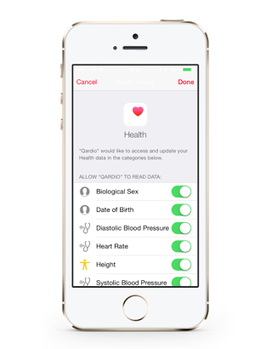Des médicaments télécommandés
18/11/2014Samsung wants its sensor-packed Simband to change your life for the better – Digital Trends
18/11/2014In-Depth: Analysis of 137 HealthKit-enabled apps
This week MobiHealthNews once again rounded up an up-to-date list of health and wellness apps that connect to Apple’s HealthKit, a health and fitness data exchange that makes it easier for iOS apps to share data with each other. For this week’s in-depth report, MobiHealthNews analyzed the ways in which these 137 health and wellness apps are integrating with HealthKit. Some only pull data from HealthKit, while others only push data into HealthKit for other apps to use. A good number — about 20 percent — do both.
This is almost certainly not an exhaustive list — apps continue to add HealthKit integrations everyday and Apple is slowly adding new fields to its platform. We also found two or three apps that claimed to connect to HealthKit but didn’t make clear exactly what kinds of data they were sharing or pulling. We left these puzzling apps out of our analysis.
While HealthKit makes it possible to share dozens of different types of health and fitness data, most HealthKit-enabled apps are making use of the same few data points. Active calories and weight data are both among the top three most popular data types to push or pull from HealthKit. Heart rate data and step count is right up there, too.
Based on MobiHealthNews’ analysis, here’s a quick breakdown of the top 10 most popular data types pushed to HealthKit and the top 10 most pulled:
Number of apps pushing various kinds of data (or “writing”) to Apple HealthKit.
34 percent of HealthKit apps (46) are pushing active calories data.20 percent of HealthKit apps (28) are pushing weight data.18 percent of HealthKit apps (25) are writing heart rate data.18 percent (24) are pushing workouts data to HealthKit, even though the Apple Health app doesn’t have such a field.15 percent of HealthKit apps (21) are feeding step count data into the platform.15 percent (20) are sharing walking and running distance data with HealthKit.10 percent of HealthKit apps (14) are pushing out sleep analysis data.9 percent (12) are sharing nutrition data with the HealthKit ecosystem.8 percent (11) are pushing out blood pressure data with HealthKit.7 percent of HealthKit apps (9) are writing cycling distance data.
Number of apps pulling various kinds of data (or “reading”) from Apple HealthKit.
23 percent of HealthKit apps (32) are pulling weight data.16 percent (22) are integrating step count data from HealthKit.12 percent (17) are using active calories data from the platform.10 percent of HealthKit apps (14) are using heart rate data pulled from the system.10 percent (14) are pulling down blood pressure data from HealthKit.9 percent (13) make use of walking and running distance data retrieved from HealthKit.9 percent (13) are pulling nutrition data from HealthKit.9 percent of HealthKit apps (12) are using sleep analysis data from the platform.7 percent of HealthKit-connected apps are using the platform to pull in a user’s height.7 percent (9) are pulling in a user’s birthdate from HealthKit.
We’ll share topline metrics on pricing data for these 137 apps later in this in-depth.
Source: mobihealthnews.com




